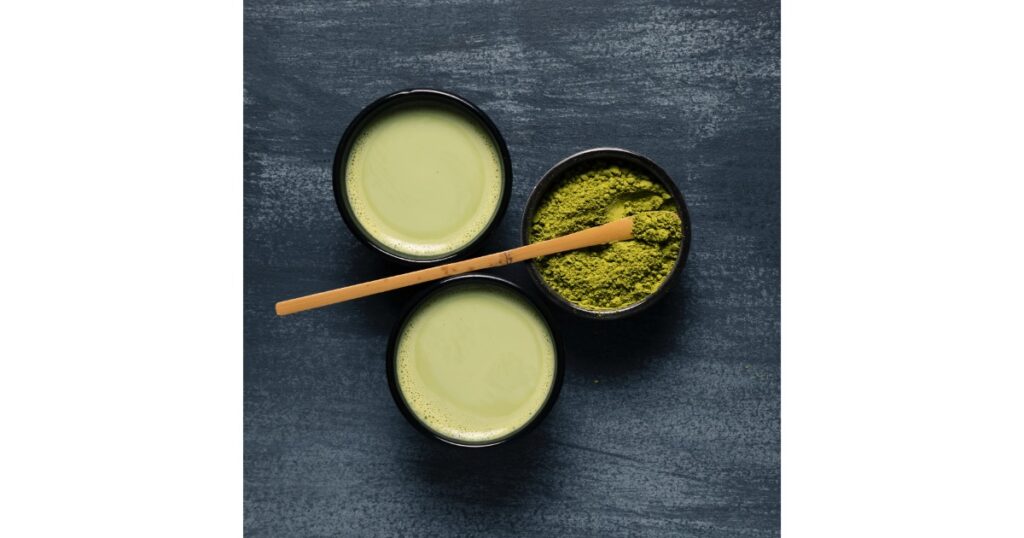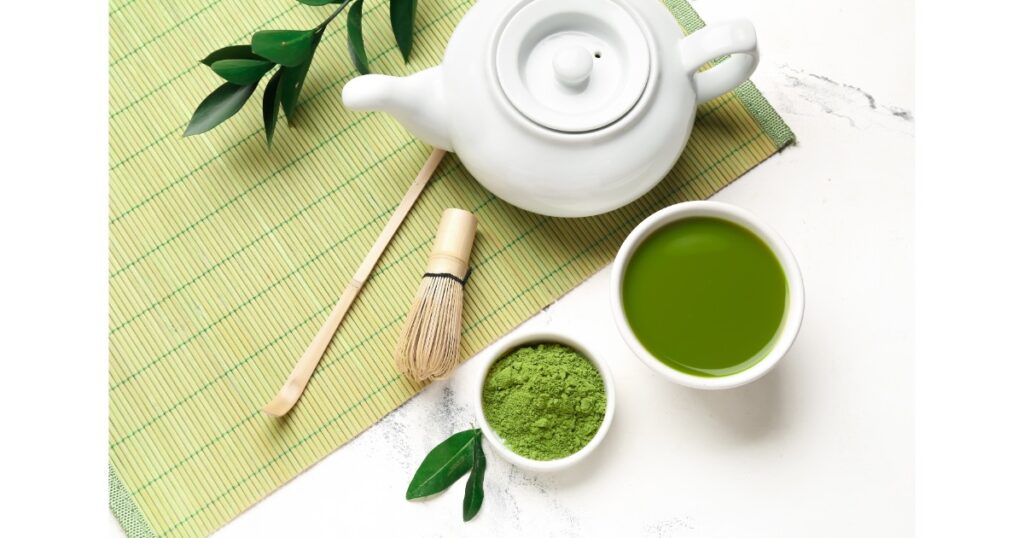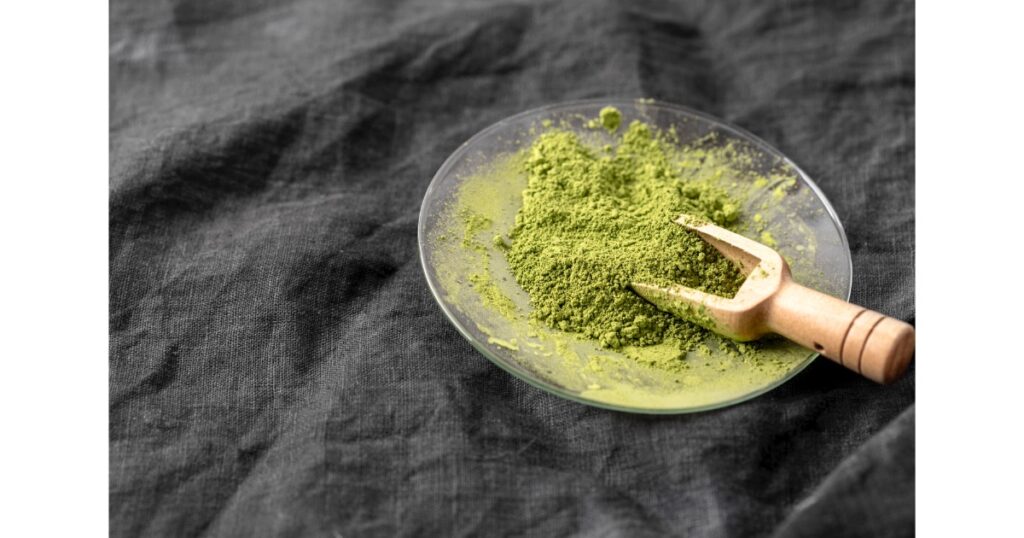Matcha Tea – This vibrant green drink has emerged as one of the best health elixirs and has successfully captured the attention of wellness enthusiasts and tea connoisseurs.
This beverage not only tantalizes taste buds but promises a symphony of benefits for both body and mind.
Matcha stands as a powerhouse of antioxidants and chlorophyll with a unique form of caffeine that imparts sustained energy without the jitters.
Curious to know more about it?
Let’s unlock the secrets of matcha green tea so that you can infuse your life with its incredible benefits.
Table of Contents
What is Matcha?

Matcha is a type of powdered green tea that has its roots deeply embedded in Japanese tradition. What sets matcha apart from other green teas is the meticulous cultivation and processing method it undergoes.
The journey of matcha begins with shade-grown tea leaves, from the Camellia sinensis plant, the same plant that gives us various types of tea.
The tea bushes are sheltered from direct sunlight for about 20-30 days before harvest. This shading process stimulates an increase in chlorophyll levels, giving the leaves a vibrant green hue and enhancing both flavour and nutritional content. The carefully harvested leaves are then steamed, dried, and ground into a fine powder to obtain matcha.
Matcha powder has gained widespread popularity due to its numerous health benefits and versatility in various culinary applications. From traditional tea to modern lattes and desserts, matcha has become a global symbol of both wellness and indulgence.
Matcha Tea Grades
If you are planning to make matcha tea a part of your daily routine, this section is important for you.
Not all matcha powders are same, they have different grades1.
Matcha tea powder comes in multiple grades that may vary based on usage, colour, cultivation, flavour, and texture. Let’s understand the different grades of matcha tea.
Ceremonial Grade Matcha Tea
- Considered as the highest quality grade of matcha2.
- Made from fresh and young tea leaves.
- Primarily used for tea purposes.
- Has vibrant green colour, smooth texture, fresh and sweet earthy smell.
Culinary Grade Matcha Tea
- Also made from fresh leaves but the leaves are not as fresh as used in ceremonial grade, hence, the flavour and texture slightly differs3.
- Ideal for baking, cooking, and smoothies.
- Has high antioxidant and catechins content.
- Has subdued green shade and not vibrant as ceremonial grade.
- Has a slightly bitter taste due to which it is used in combination with different ingredients while baking or cooking.
Premium Grade Matcha Tea
- Has a rich balanced and neutral taste, smooth flavour, and beautiful green colour.
- Can be enjoyed in latte and other beverages.
- Not suitable for baking.
Scientifically Proven Matcha Tea Benefits
These are a few health benefits associated with matcha powder.
Potent Antioxidant Source
This Japanese green tea housed many strong antioxidants including epicatechin (EC), epicatechin-3-gallate (ECG), epigallocatechin (EGC), and epigallocatechin-3-gallate (EGCG)4.
Free radicals in the body increase the risk of inflammation and metabolic disorders like diabetes, cardiovascular diseases, etc.
The catechins in matcha green tea exhibit exceptional antioxidant activity by neutralizing free radicals and boosting the detoxification.
Rich in Vitamin C
Matcha green tea is also rich in vitamin C. The amount generally varies between 1.63-3.98 mg/g, depending on the product type and its origin.
Vitamin C is an essential mineral needed for various processes in the body including immune function, collagen synthesis, and free radical destruction.
Glowing Skin and a Youthful Appearance
The antioxidants in matcha contribute to skin health by protecting against UV radiation and promoting overall skin elasticity. Some topical applications of matcha are also used for skincare.
Sipping on matcha not only means enjoying a delicious tea, but also giving your skin a daily dose of defence against wrinkles and promoting a natural, healthy glow.
Support Healthy Weight
The combination of caffeine and unique compounds in matcha, such as EGCG, has been shown to increase metabolic rate and fat burning. It makes matcha a popular choice for those looking to support weight loss.
A study published in the International Journal of Sports Nutrition and Exercise Metabolism observed matcha increased fat oxidation among females who consumed matcha tea regularly before brisk walking.5
You may consider starting your day with a matcha smoothie or tea to kickstart your metabolism. It is a tasty way to support your fitness goals without sacrificing flavour.
Immunity Booster
Regular consumption of matcha may help the body defend against infections and illnesses as the antioxidants in matcha possess immune-boosting properties.
Think of it as your daily shield against common colds. A warm cup can be your delicious weapon to help you stay strong and healthy throughout the year.

Support Detoxification
Chlorophyll, the green pigment in matcha, is known for its detoxifying properties. It helps to eliminate heavy metals and chemicals from the body, supporting overall detoxification processes.
It encourages daily cleansing, promoting overall well-being from the inside out.
Healthy Blood Sugar Levels
Some studies suggest that matcha may help regulate blood sugar levels, which is beneficial for individuals with diabetes or those at risk of developing the condition.
This benefit is also because of the presence of another antioxidant in matcha powder – quercetin. Studies have shown that quercetin promote typical carbohydrate metabolism by inhibiting glucose absorption, regulating insulin secretion and improving insulin sensitivity in tissues6.
Heart Healthy
You can consider matcha green tea in your daily routine to keep your heart healthy.
Regular intake has been linked with a healthy lipid profile and cholesterol levels. It prevents the accumulation of harmful LDL cholesterol in the body minimizing the occurrence of cardiovascular disorders.
Support Brain Function
If you are one of those whose days can not start without a cup of tea or coffee, try swapping your usual beverage with a matcha latte to experience a sustained, jitter-free boost, better focus, and energy levels for staying sharp during meetings or tackling that to-do list.
Matcha contains a moderate amount of caffeine, providing a more sustained release of energy compared to coffee.
This can lead to increased alertness and improved concentration without the jittery side effects often associated with other caffeinated beverages.
Relieve Stress and Uplift Mood
Matcha is rich in L-theanine, an amino acid that induces a state of alert and relaxation.
The combination of L-theanine and caffeine is believed to induce a state of “calmness,” reducing stress and enhancing mood.
How Does Matcha Taste?
Matcha has a distinctive and complex flavour profile that sets it apart from other types of green tea. The taste of matcha tea is influenced by various factors, including the quality of the tea leaves, the growing conditions, and the processing methods.
If you want to have a deep understanding of the flavour characteristics of matcha tea, here is a breakdown for your reference.
- Umami – Umami is often described as a savory, brothy, or slightly seaweed-like flavour. Matcha is known for its rich umami taste, which is a result of the shading process the tea leaves undergo before harvest.
- Bitterness – Matcha can have a dash of bitterness. However, when prepared correctly, the bitterness can be balanced.
- Sweetness – High-quality matcha possesses a natural sweetness, often described as a sweet grass. This sweetness helps to counterbalance the bitterness and contributes to the overall harmonious flavour.
- Creaminess – When properly whisked, matcha develops a creamy and frothy texture.
- Astringency – Some level of astringency, or a drying sensation in the mouth, can be present in matcha.
- Clean Finish – Well-prepared matcha leaves a clean and refreshing aftertaste.
The taste of matcha can vary from one grade to another. If you are new to matcha, experimenting with different grades and preparation methods may help you find the style that suits your palate best.
Here is A Guide with Step-By-Step Instructions On How To Make Matcha Tea
Matcha green tea is considered one of the highest-quality tea due to its health-promoting properties.
Making matcha tea involves a few simple steps.
Ingredients:
- Matcha powder
- How Water
- Sweetener and Milk (Optional)
Tools:
- Bamboo matcha whisk and teaspoon
- Match bowl
- Sifter
Recipe:
- Pour a small amount of hot water into the matcha bowl to warm it. Swirl the water around and then discard it.
- Use a bamboo scoop or teaspoon to measure out 1/2 to 1 teaspoon of matcha powder into the sifter. Sift the matcha into the bowl to ensure a smooth, lump-free mixture.
- Pour about 60 ml of hot water into the matcha bowl with the sifted matcha powder.
- Using the bamboo matcha whisk, whisk the matcha and water until a frothy layer forms on top.
- If you like a thinner consistency, you can add more hot water.
- If you prefer a matcha latte, you can heat and froth milk separately and then pour it into the matcha mixture.
- If desired, add a sweetener of your choice.
Matcha is best enjoyed fresh, so drink it immediately after preparation to savour its vibrant flavour and frothy texture.
P.S. Clean your matcha tools immediately after use to maintain their longevity.
Matcha vs Green Tea – Which is Better & Healthier?
Both matcha and green tea offer various health benefits, but they differ in terms of preparation, flavour, and nutritional content.
Whether one is better depends on individual preferences and health goals.
- Matcha has a unique, rich, and complex flavour with a strong umami taste. It can be slightly bitter and sweet. Green tea has a milder flavour than matcha, with a fresh and slightly astringent taste.
- Matcha is known for its higher concentration of antioxidants, particularly catechins like EGCG. They are also present in green tea but in slightly lower concentrations than matcha.
- Green tea contains caffeine, but the levels are generally lower than in matcha. If you are sensitive to caffeine, green tea may be a more suitable option.
Matcha Tea Side Effects You Should Know
Matcha tea is generally considered safe for most people when consumed in moderation. Here are some possible side effects for people with caffeine sensitivities or any medical conditions.
- Matcha contains caffeine, which may cause side effects such as insomnia, jitteriness, increased heart rate, or digestive issues in individuals sensitive to caffeine.
- Excessive consumption of matcha tea on an empty stomach may lead to stomach upset or digestive discomfort.
- Some individuals may be allergic to tea, including matcha.
- Matcha may interact with certain medications. Individuals taking medications should consult with their healthcare provider, especially if they are on blood thinners or stimulant medications.
- Some studies have suggested that certain teas, including green tea, may contain traces of heavy metals. Therefore, it is always the best to choose matcha tea from reputable sources that provide information on quality and testing.
- Matcha, like other green teas, contains oxalates. Those with a history of kidney stones are advisable to keep the intake in moderation.
Best Ways To Use Matcha Powder

If you like experimenting, here are a few creative ways to use matcha powder.
- Matcha Tea – The traditional and most straightforward use is to whisk matcha powder with hot water to make a frothy cup of matcha tea.
- Matcha Latte – Mix matcha powder with steamed milk and a sweetener of your choice to create a comforting matcha latte. This can be done with dairy or non-dairy milk alternatives.
- Smoothies – Boost your smoothies with a nutritional kick by adding a teaspoon of matcha powder. It pairs well with fruits like banana, pineapple, or mango.
- Matcha Ice Cream – Create homemade matcha ice cream by incorporating matcha powder into the ice cream base.
- Baking – Add matcha powder to your favourite baking recipes, such as cookies, muffins, cakes, or brownies. Matcha imparts a unique flavour and a striking green hue.
- Matcha Pancakes or Waffles – Mix matcha powder into your pancake or waffle batter for a delightful treat.
- Matcha Overnight Oats – Stir matcha powder into your overnight oats for a nutritious and energizing breakfast option. Top with fruits and nuts for added flavour and texture.
- Matcha Yogurt Parfait – Layer matcha-infused yogurt with granola, berries, and honey to create a delicious parfait.
- Matcha Chia Pudding – Combine matcha powder with chia seeds, milk, and sweetener to make a flavourful and nutrient-packed chia pudding.
- Matcha Salad Dressing – Whisk matcha powder into your favorite salad dressing for a burst of flavor and a healthful touch. It pairs well with citrus-based dressings.
- Matcha Soups – Infuse soups, especially those with a creamy or coconut base, with matcha powder to add a subtle earthy note.
- Matcha Energy Bites – Combine matcha powder with nuts, seeds, and sweeteners to create energy bites or bars. These make for a convenient and nutritious snack.
Summary
As we close this chapter on matcha, it won’t be wrong to say that it is not merely a superfood but a companion on our journey to wellness, nourishing our body.
Matcha tea is full of antioxidants and has an impressive nutritional profile. It is easily available, versatile to use, and excellent for overall vitality.
Let’s give a little cheer for matcha!
Frequently Asked Questions
What is the caffeine content of matcha green tea?
Matcha contains slightly high caffeine than other green teas. As per studies, the content of caffeine in green teas typically ranges between 11.3-24.67 mg/g, while in matcha it varies between 18.9-44.4 mg/g.
What is matcha tea, and how is it different from regular green tea?
Matcha is a type of powdered green tea that is made from shade-grown tea leaves. The entire tea leaf is ground into a fine powder, and you consume the whole leaf when drinking matcha. This is different from regular green tea, where the leaves are steeped in hot water, and only the infused liquid is consumed.
What are the health benefits of drinking matcha tea?
Matcha is rich in antioxidants, particularly catechins, which have been associated with various health benefits, including improved heart health, enhanced metabolism, and potential cancer-fighting properties. It also contains L-theanine, promoting relaxation and mental alertness.
What are some matcha tea benefits for skin?
Drinking matcha tea contributes to overall hydration, which is essential for maintaining skin moisture. Hydrated skin tends to appear plumper and more youthful. Its high antioxidant content also help reduce premature skin ageing, puffiness, skin inflammation, and dullness.
Can I use matcha powder in recipes other than tea?
You may add matcha powder to cakes, smoothies, pancakes, soups, lattes, and puddings.
Does matcha really help with weight loss?
Some studies suggest that the antioxidants in matcha may aid in weight loss by boosting metabolism and burning fat. However, a balanced diet and regular exercise are crucial for effective weight management.
Can I add sweeteners to my matcha tea without compromising its health benefits?
Yes, you can add sweeteners as per your liking.
Is matcha suitable for children to drink?
Yes, matcha is generally safe for children. However, moderation is the key.
What is the best way to store matcha powder to keep it fresh?
Store matcha in an airtight container in a cool, dark place to prevent exposure to light and air.
Are there any alternatives to using a traditional bamboo whisk for preparing matcha?
One may use electric frothers, traditional whisks, or even a fine-mesh sieve for preparing matcha.
What are some common myths or misconceptions about matcha?
Common myths related to match tea typically revolves around exaggerated weight loss claims, confusion about grades, and misconceptions about its caffeine content.
Sources
- Michalska, M. (2022, October 17). The different Matcha grades and categories | Matchaoutlet.com. Matcha Outlet. https://matchaoutlet.com/blogs/articles/the-different-matcha-grades-and-categories-matchaoutletcom ↩︎
- Hadjipateras, E. (2023, December 5). Quality & different grades of Matcha Green Tea powder. Matcha.com. https://matcha.com/blogs/news/a-guide-to-different-matcha-grades-and-categories ↩︎
- Api, S. (2021, January 6). Different Matcha Grades: An Idiot-Proof Guide. Crafti. https://getcrafti.sg/blogs/articles/different-matcha-grades ↩︎
- Kochman, J., Jakubczyk, K., Antoniewicz, J., Mruk, H., & Janda, K. (2020). Health benefits and chemical composition of matcha green tea: a review. Molecules, 26(1), 85. https://doi.org/10.3390/molecules26010085 ↩︎
- Willems, M. E. T., Şahin, M. A., & Cook, M. D. (2018). Matcha green tea drinks enhance fat oxidation during brisk walking in females. International Journal of Sport Nutrition and Exercise Metabolism, 28(5), 536–541. https://doi.org/10.1123/ijsnem.2017-0237 ↩︎
- Ansari, P., Choudhury, S. T., Seidel, V., Rahman, A. B., Aziz, M. A., Richi, A. E., Rahman, A., Jafrin, U. H., Hannan, J. M. A., & Abdel-Wahab, Y. (2022). Therapeutic potential of quercetin in the management of type-2 diabetes mellitus. Life, 12(8), 1146. https://doi.org/10.3390/life12081146 ↩︎
